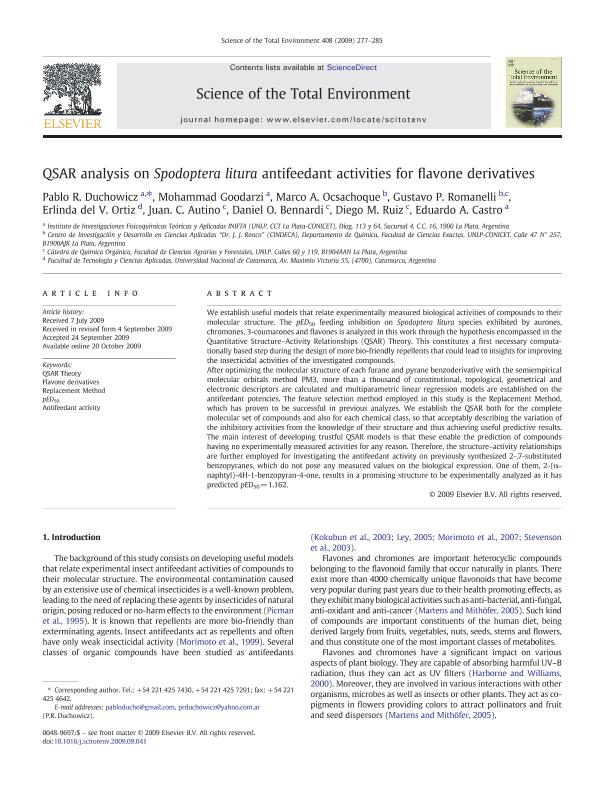Artículo
QSAR analysis on Spodoptera litura antifeedant activities for flavone derivatives
Duchowicz, Pablo Román ; Goodarzi, Mohammad; Ocsachoque, Marco Antonio
; Goodarzi, Mohammad; Ocsachoque, Marco Antonio ; Romanelli, Gustavo Pablo
; Romanelli, Gustavo Pablo ; Ortiz, Erlinda del Valle
; Ortiz, Erlinda del Valle ; Autino, Juan C.; Bennardi, Daniel Oscar; Ruiz, Diego Manuel
; Autino, Juan C.; Bennardi, Daniel Oscar; Ruiz, Diego Manuel ; Castro, Eduardo Alberto
; Castro, Eduardo Alberto
 ; Goodarzi, Mohammad; Ocsachoque, Marco Antonio
; Goodarzi, Mohammad; Ocsachoque, Marco Antonio ; Romanelli, Gustavo Pablo
; Romanelli, Gustavo Pablo ; Ortiz, Erlinda del Valle
; Ortiz, Erlinda del Valle ; Autino, Juan C.; Bennardi, Daniel Oscar; Ruiz, Diego Manuel
; Autino, Juan C.; Bennardi, Daniel Oscar; Ruiz, Diego Manuel ; Castro, Eduardo Alberto
; Castro, Eduardo Alberto
Fecha de publicación:
12/2009
Editorial:
Elsevier Science
Revista:
The Science Of Total Environment
ISSN:
0048-9697
Idioma:
Inglés
Tipo de recurso:
Artículo publicado
Clasificación temática:
Resumen
We establish useful models that relate experimentally measured biological activities of compounds to their molecular structure. The pED50 feeding inhibition on Spodoptera litura species exhibited by aurones, chromones, 3-coumarones and flavones is analyzed in this work through the hypothesis encompassed in the Quantitative Structure?Activity Relationships (QSAR) Theory. This constitutes a first necessary computationally based step during the design of more bio-friendly repellents that could lead to insights for improving the insecticidal activities of the investigated compounds.<br />After optimizing the molecular structure of each furane and pyrane benzoderivative with the semiempirical molecular orbitals method PM3, more than a thousand of constitutional, topological, geometrical and electronic descriptors are calculated and multiparametric linear regression models are established on the antifeedant potencies. The feature selection method employed in this study is the Replacement Method, which has proven to be successful in previous analyzes. We establish the QSAR both for the complete molecular set of compounds and also for each chemical class, so that acceptably describing the variation of the inhibitory activities from the knowledge of their structure and thus achieving useful predictive results. The main interest of developing trustful QSAR models is that these enable the prediction of compounds having no experimentally measured activities for any reason. Therefore, the structure?activity relationships are further employed for investigating the antifeedant activity on previously synthesized 2-,7-substituted benzopyranes, which do not pose any measured values on the biological expression. One of them, 2-(α-naphtyl)-4H-1-benzopyran-4-one, results in a promising structure to be experimentally analyzed as it has predicted pED50=1.162.
Archivos asociados
Licencia
Identificadores
Colecciones
Articulos(CINDECA)
Articulos de CENTRO DE INV EN CS.APLICADAS "DR.JORGE J.RONCO"
Articulos de CENTRO DE INV EN CS.APLICADAS "DR.JORGE J.RONCO"
Articulos(INIFTA)
Articulos de INST.DE INV.FISICOQUIMICAS TEORICAS Y APLIC.
Articulos de INST.DE INV.FISICOQUIMICAS TEORICAS Y APLIC.
Citación
Duchowicz, Pablo Román; Goodarzi, Mohammad; Ocsachoque, Marco Antonio; Romanelli, Gustavo Pablo; Ortiz, Erlinda del Valle; et al.; QSAR analysis on Spodoptera litura antifeedant activities for flavone derivatives; Elsevier Science; The Science Of Total Environment; 408; 2; 12-2009; 277-285
Compartir
Altmétricas



